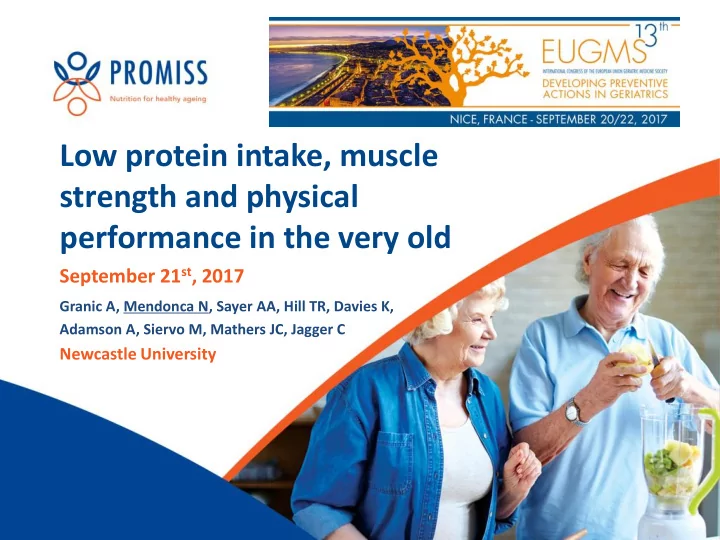

Low protein intake, muscle strength and physical performance in the very old September 21 st , 2017 Granic A, Mendonca N, Sayer AA, Hill TR, Davies K, Adamson A, Siervo M, Mathers JC, Jagger C Newcastle University
Causes of non-optimal protein intake and utilisation in older adults Muscle strength & Physical performance Bauer et al 2013: PROT-AGE study group position paper, EUGMS
Protein requirements • RDA 0.8 g/kg BW/d does not take into account multimorbidity, physiological changes, reduced physical activity and appetite in the very old 1-3 • 1-1.5 g/kg BW/d – 25-30g/meal (~10g EAA) – adjusted (ideal) body weight 4 1 . Paddon-Jones D, Leidy H. Curr Opin Clin Nutr Metab Care 2014;17:5-11. 2 . Bauer J et al . J Am Med Dir Assoc 2013;14:542- 559. 3 . Deutz NE et al Clin Nutr 2014;33:929-936. 4 . Berner LA et al . J Acad Nutr Diet 2013;113:809-815.
Aims • Association low protein intake (<1 g/ kg aBW/d), and muscle strength (grip strength, GS) and physical performance (Timed Up-and-Go, TUG) in the very old over 5 years. • Explore if physical activity (PA) and protein intake distribution across the day influence these relationships.
The Newcastle 85+ Study + 845 188 with health assessments GP records data only and GP records data 805 consented to dietary assessment Excluded 12 with a single-day diet recall 793 (98.5%) complete 2x24-MPR Excluded 2 without health assessment Analytic sample 791 722 with complete lived in community baseline data
Methods • Protein intake • 2x24hr MPR to estimate protein intake • <1 g/kg aBW/d (Low protein intake) * • ≥1 g/kg aBW/d (Good protein intake). • Outcomes • Decline in GS and TUG (baseline, 1.5, 3 and 5y follow-up) • Mixed linear models (stratified by sex and protein intake group) • Confounders • Anthropometry, health-related, diet-related, life style, attrition * Adjusted body weight to reflect a healthy BMI in those ≥71, Berner LA et al J Acad Nutr Diet 2013;113:809-15
GS decline by protein intake in men 16 14 Low protein : 12 <1 g/kg aBW/d Good protein : β estimates for GS (kg) 10 ≥ 1g/kg aBW/d 8 n =289 6 4 2 Lineare (Low protein) Lineare (Good protein) 0 0 1 2 3 4 5 6 Time (years) • no association between low protein intake and GS in men. • Protein distribution was not associated with GS in men.
10 GS decline by protein intake in women 9 8 β estimates for GS (kg) 7 Low protein : <1 g/kg aBW/d 6 Good protein : 5 ≥1 g/kg aBW/d -0.83 (0.41), p=0.046 4 n =433 3 2 Lineare (Low protein) 1 Lineare (Good protein) 0 0 1 2 3 4 5 6 Time (years) • association between low protein intake and GS at baseline • not with GS decline over time • protein distribution was not a significant predictor of GS
GS decline in low and good protein intake group 14 by levels of PA 12 10 β estimates for GS (kg) High P*time β (SE)= 0.83 (0.27), p=0.002 8 Moderate PA*time β (SE)= 0.77 (0.27), p=0.005 6 Lineare (Low protein - High PA) High PA: Lineare (Low protein - 4 Moderate PA) β (SE)= 4.44 Lineare (Low protein - (0.98) Low PA) Moderate PA: Lineare (Good protein - β( SE)= 4.1 High PA) 2 Lineare (Good protein - (0.92), Moderate PA) P<0.001 (both) Lineare (Good protein - Low PA) 0 0 1 2 3 4 5 6 Time (years) • ↑PA predicted the rate of GS decline in the good protein intake group (grey lines), but not the rate in low protein (black lines). • good protein intake group with low PA had the worst GS trajectory.
Decline in TUG by protein intake in men 1,6 1,55 β estimates for TUG (log10 s) 1,5 1,45 1,4 Poli. (Low protein) 1,35 Poli. (Good protein) 1,3 0 1 2 3 4 5 6 Time (years) • low protein intake was not associated with TUG in men. • no significant interactions (PA*time)
Decline in TUG by protein intake in women 1,54 1,52 β estimate for TUG (log10 s) 1,5 1,48 1,46 β (SE)=0.04(0.02), p=0.03 1,44 Poli. (Low protein) 1,42 Poli. (Good protein) 1,4 0 1 2 3 4 5 6 Time (year) • low protein intake was associated with worse TUG at baseline only in women • no interactions (PA*time) were found • protein distribution was not associated with TUG
Conclusion • Protein intake <1g/ kg aBW/d was associated with -0.83 kg GS and worse TUG in women at baseline only after adjustment for a range of confounders • Confirms previous reports that a higher protein intake above the current RDA is needed • Suggests that higher PA may be ineffective in the very old if protein intake is not adequate
Acknowledgement Funding for this research is provided by the European Horizon 2020 PROMISS Project ‘Prevention Of Malnutrition In Senior Subjects in the EU’, Grant agreement no. 678732 (AG, CJ). The content only reflects the author’s view and the Commission is not responsible for any use that may be made of the information it contains. Thank you
Recommend
More recommend